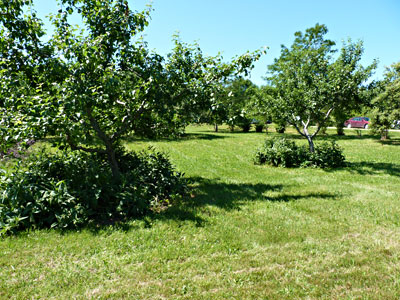 |
| Comfrey growing under an apple tree at John Bunker’s Super Chilly Farm in Palermo and at Judy Berk and David Foley’s Ocean Glimpse Farm in Northport. Comfrey is a dynamic accumulator – a taprooted plant that draws nutrients up from deep in the soil and cycles them to orchard plants. English photos. |
 |
By C.J. Walke
Driving by a fruit tree orchard or walking through a local pick-your-own operation, we typically see long rows of evenly spaced trees, where the undergrowth is regularly mowed to reduce competition for vital nutrients and the overall look is one of uniformity. This design focuses on labor efficiency, where long rows facilitate the mechanical chores of mowing, spraying, irrigating and harvesting, helping reduce costs and improve profits. In the home orchard and garden, we tend to follow the same patterns for similar reasons, but here, the random can be righteous and the haphazard can be helpful.
I view the orchard as an ecosystem, where all life is connected and health depends on diversity. Even pests have their place, as a European apple sawfly pollinates an apple blossom on its way to laying an egg at the base of the flower. We don’t really want to encourage pest populations, but they are part of the bigger picture of building diversity in the orchard, avoiding the imbalance of monoculture and creating a dynamic polyculture.
Polyculture, one of the principles of permaculture, imitates the diversity of natural ecosystems through intercropping, companion planting and layering, where various crops inhabit different spaces, from smaller annuals to woody shrubs and climbing vines to towering trees. MOFGA’s South Orchard was originally designed as an inter-cropping/alley cropping demonstration, where vegetable crops were cultivated between rows of young trees. Now that the trees are bearing fruit and shading a lot of the orchard floor, full sun for vegetable crops is no longer available, so we are shifting to shade tolerant plants and perennials that build diversity, accumulate nutrients and support beneficial insects.
Dynamic Accumulators
The holistic approaches of permaculture speak of dynamic accumulators – tap-rooted plants that absorb nutrients from deeper layers of the soil profile. As these plants die and decompose, their plant matter and nutrients become available to other plants in the orchard. Legumes are also part of this group, since their root-colonizing bacteria “fix” atmospheric nitrogen gas into a usable form for other crops. Incorporating dynamic accumulators into your orchard ecosystem helps recycle vital nutrients, break up thick sod patches and build the soil from the top down.
A few common dynamic accumulators are comfrey, stinging nettle and red clover. Comfrey is a tap-rooted perennial that mines calcium (essential for fruit ripening and storage), produces ample organic matter as it decomposes and provides nectar for bumblebees, since it blooms shortly after apples and pears. Nettles are high in silica, and nettle tea can be sprayed on fruit trees to help build the cuticle layer on leaves and fruit. Red clover, a nitrogen-fixing legume, produces a more fungal environment in the soil and provides nectar for bumblebees.
Comfrey and nettle do come with warnings. If land where comfrey is planted is ever tilled, that tilling can spread the plant by spreading pieces of its rhizome. A large area of comfrey can be very difficult to eliminate.
Nettles can spread by seed and rhizomes, and anyone who has grabbed the stem or leaves of these plants knows that they contain stinging hairs. To prevent nettles from spreading by seed, cut plants before they go to seed. Feed the cut plants to chickens or make nettle tea. As with comfrey, don’t till ground where nettles grow; doing so can spread the plant by moving pieces of rhizomes to new ground.
Beneficial Accumulators
Beneficial accumulator is another permaculture term referring to plants that provide habitat, food or shelter for beneficial invertebrates, such as insects and spiders. These critters help orchard trees through efficient pollination (insects) and by preying upon harmful pests (insects and spiders). Umbelliferous plants (lovage, sweet cicely, Queen Anne’s lace – members of the Umbelliferae or Apiaceae family) attract solitary bees of the Osmia species, which are very efficient pollinators – a few hundred can pollinate an acre of fruit trees. Other small-flowered plants (lavender, thyme, buckwheat) attract parasitic wasps and syrphid flies (hoverflies), which prey on pest larvae. Parasitic wasps lay eggs in or on the bodies of pest larvae, while syrphid fly larvae eat an estimated 40 aphids per day.
In the MOFGA orchards I have been planting dynamic and beneficial accumulators to help build fertility, recycle nutrients and build populations of beneficial invertebrates. A new tree row in the North Orchard has a comfrey plant at the base of each tree (with more to come) and has been cover cropped with buckwheat and red and crimson clover. Sweet cicely and creeping geranium have been planted throughout our plum thicket. Most importantly, the mixture of vegetables, fruits and other crops we grow at our Common Ground Education Center, without the use of broad-spectrum chemical pesticides, supports a wide biological diversity and creates a healthy agricultural ecosystem.
C.J. Walke is MOFGA’s development associate, librarian and organic orchardist. You can address your orcharding questions to him at 568-4142 or [email protected].
